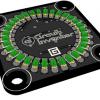Hello all,
I am working on a project with my Netduino Plus 2. I am encountering a strange problem.
In a nutshell, the device I'm designing is running tests on a circuit board to check for functionality. I am using the Netduino to send signals to this board. I have 6 push-buttons that trigger interrupts which send certain signals to the board being tested. If the correct level is detected at this board's output pin, a corresponding LED is turned on. If an incorrect level is detected, the LED is flashed. The interrupt ports are interruptedgehigh with accompanying pull down resistors. The N+2 is being powered by 8 volts coming from a power supply circuit which itself is powered with your basic 120VAC.
The board I am testing requires 120VAC to be sent through 4 paths one at a time. This tests functionality of the components located on that particular path. So I have 4 line/neutral pairs sent to the board. But since the paths must be run one at a time, I have each line switched. This way, when I want to run the AC line tests, I flip line switch 1, press the test's push-button to trigger the interrupt which runs the test, and then check the test results via the LED.
using System;
using System.Net;
using System.Net.Sockets;
using System.Diagnostics;
using System.Threading;
using Microsoft.SPOT;
using Microsoft.SPOT.Hardware;
using SecretLabs.NETMF.Hardware;
using SecretLabs.NETMF.Hardware.Netduino;
namespace TLS_350_Pump_Sense_Module_Test_Program
{
public class Program
{
private static InterruptPort LT1Switch = new InterruptPort(Pins.GPIO_PIN_D6, true, Port.ResistorMode.Disabled, Port.InterruptMode.InterruptEdgeHigh);
private static InterruptPort LT2Switch = new InterruptPort(Pins.GPIO_PIN_D7, true, Port.ResistorMode.Disabled, Port.InterruptMode.InterruptEdgeHigh);
private static InterruptPort LT3Switch = new InterruptPort(Pins.GPIO_PIN_D2, true, Port.ResistorMode.Disabled, Port.InterruptMode.InterruptEdgeHigh);
private static InterruptPort LT4Switch = new InterruptPort(Pins.GPIO_PIN_D3, true, Port.ResistorMode.Disabled, Port.InterruptMode.InterruptEdgeHigh);
private static InterruptPort TransTestSwitch = new InterruptPort(Pins.GPIO_PIN_D5, true, Port.ResistorMode.Disabled, Port.InterruptMode.InterruptEdgeHigh);
private static InterruptPort U1TestSwitch = new InterruptPort(Pins.GPIO_PIN_D4, true, Port.ResistorMode.Disabled, Port.InterruptMode.InterruptEdgeHigh);
private static OutputPort J1pin3 = new OutputPort(Pins.GPIO_PIN_D0, false);
private static InputPort J1pin4 = new InputPort(Pins.GPIO_PIN_D13, true, Port.ResistorMode.Disabled);
private static OutputPort J1pin5 = new OutputPort(Pins.GPIO_PIN_D9, false);
private static OutputPort J1pin7 = new OutputPort(Pins.GPIO_PIN_D10, false);
private static OutputPort J1pin9 = new OutputPort(Pins.GPIO_PIN_D11, false);
private static OutputPort J1pin10 = new OutputPort(Pins.GPIO_PIN_D12, true);
private static OutputPort LT1LED = new OutputPort(Pins.GPIO_PIN_D8, false);
private static OutputPort LT2LED = new OutputPort(Pins.GPIO_PIN_A1, false);
private static OutputPort LT3LED = new OutputPort(Pins.GPIO_PIN_A2, false);
private static OutputPort LT4LED = new OutputPort(Pins.GPIO_PIN_A3, false);
private static OutputPort TTLED = new OutputPort(Pins.GPIO_PIN_A4, false);
private static OutputPort U1TLED = new OutputPort(Pins.GPIO_PIN_A5, false);
private static DateTime lastEvent = DateTime.Now;
public static double ReadRaw()
{
AnalogInput TransistorTest = new AnalogInput(AnalogChannels.ANALOG_PIN_A0);
const double maxVoltage = 3.3;
const int maxADCValue = 4095;
double rawValue = TransistorTest.ReadRaw();
TransistorTest.Dispose();
double voltagevalue = (rawValue * maxVoltage) / maxADCValue;
double realworldvalue=(((voltagevalue - 0.5) * 1000) / 10) - 4;
return voltagevalue;
}
public static void Main()
{
TransTestSwitch.OnInterrupt += new NativeEventHandler(TransTestSwitch_OnInterrupt);
LT1Switch.OnInterrupt += new NativeEventHandler(LT1Switch_OnInterrupt);
LT2Switch.OnInterrupt += new NativeEventHandler(LT2Switch_OnInterrupt);
LT3Switch.OnInterrupt += new NativeEventHandler(LT3Switch_OnInterrupt);
LT4Switch.OnInterrupt += new NativeEventHandler(LT4Switch_OnInterrupt);
U1TestSwitch.OnInterrupt += new NativeEventHandler(U1TestSwitch_OnInterrupt);
Debug.Print(ReadRaw().ToString("f"));
Thread.Sleep(300);
Thread.Sleep(Timeout.Infinite);
}
static void U1TestSwitch_OnInterrupt(uint data1, uint data2, DateTime time)
{
J1pin3.Write(false);
J1pin5.Write(true);
J1pin7.Write(false);
J1pin4.Read();
U1TestSwitch.ClearInterrupt();
if (time.AddMilliseconds(-500) > lastEvent)
{
lastEvent = time.AddMilliseconds(500);
if (J1pin4.Read() == true)
{
U1TLED.Write(true);
}
else
{
int U1number = 7;
for (int i = 0; i < U1number; i++)
{
U1TLED.Write(true);
Thread.Sleep(200);
U1TLED.Write(false);
Thread.Sleep(200);
}
}
}
}
static void TransTestSwitch_OnInterrupt(uint data1, uint data2, DateTime time)
{
J1pin3.Write(true);
J1pin5.Write(true);
J1pin7.Write(true);
J1pin9.Write(true);
ReadRaw();
TransTestSwitch.ClearInterrupt();
if (time.AddMilliseconds(-500) > lastEvent)
{
lastEvent = time.AddMilliseconds(500);
if (ReadRaw() > 2.4 && ReadRaw() <= 2.7)
{
TTLED.Write(true);
Debug.Print(ReadRaw().ToString("f"));
Thread.Sleep(300);
}
else
{
int Tnumber = 7;
for (int i = 0; i < Tnumber; i++)
{
TTLED.Write(true);
Thread.Sleep(200);
TTLED.Write(false);
Thread.Sleep(200);
}
}
}
}
static void LT1Switch_OnInterrupt(uint data1, uint data2, DateTime time)
{
J1pin3.Write(false);
J1pin5.Write(false);
J1pin7.Write(false);
J1pin4.Read();
LT1Switch.ClearInterrupt();
if (time.AddMilliseconds(-500) > lastEvent)
{
lastEvent = time.AddMilliseconds(500);
if (J1pin4.Read() == false)
{
LT1LED.Write(true);
}
else
{
int L1number = 7;
for (int i = 0; i < L1number; i++)
{
LT1LED.Write(true);
Thread.Sleep(200);
LT1LED.Write(false);
Thread.Sleep(200);
}
}
}
}
static void LT2Switch_OnInterrupt(uint data1, uint data2, DateTime time)
{
J1pin3.Write(true);
J1pin5.Write(false);
J1pin7.Write(false);
J1pin4.Read();
LT2Switch.ClearInterrupt();
if (time.AddMilliseconds(-500) > lastEvent)
{
lastEvent = time.AddMilliseconds(500);
if (J1pin4.Read() == false)
{
LT2LED.Write(true);
}
else
{
int L2number = 7;
for (int i = 0; i < L2number; i++)
{
LT2LED.Write(true);
Thread.Sleep(200);
LT2LED.Write(false);
Thread.Sleep(200);
}
}
}
}
static void LT3Switch_OnInterrupt(uint data1, uint data2, DateTime time)
{
J1pin3.Write(false);
J1pin5.Write(true);
J1pin7.Write(false);
J1pin4.Read();
LT3Switch.ClearInterrupt();
if (time.AddMilliseconds(-500) > lastEvent)
{
lastEvent = time.AddMilliseconds(500);
if (J1pin4.Read() == false)
{
LT3LED.Write(true);
}
else
{
int L3number = 7;
for (int i = 0; i < L3number; i++)
{
LT3LED.Write(true);
Thread.Sleep(200);
LT3LED.Write(false);
Thread.Sleep(200);
}
}
}
}
static void LT4Switch_OnInterrupt(uint data1, uint data2, DateTime time)
{
J1pin3.Write(true);
J1pin5.Write(true);
J1pin7.Write(false);
J1pin4.Read();
LT4Switch.ClearInterrupt();
if (time.AddMilliseconds(-500) > lastEvent)
{
lastEvent = time.AddMilliseconds(500);
if (J1pin4.Read() == false)
{
LT4LED.Write(true);
}
else
{
int L4number = 7;
for (int i = 0; i < L4number; i++)
{
LT4LED.Write(true);
Thread.Sleep(200);
LT4LED.Write(false);
Thread.Sleep(200);
}
}
}
}
}
}















